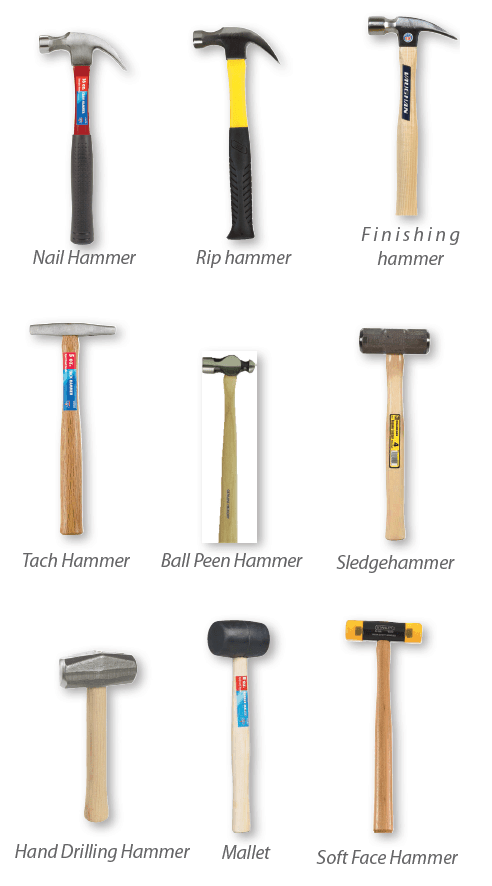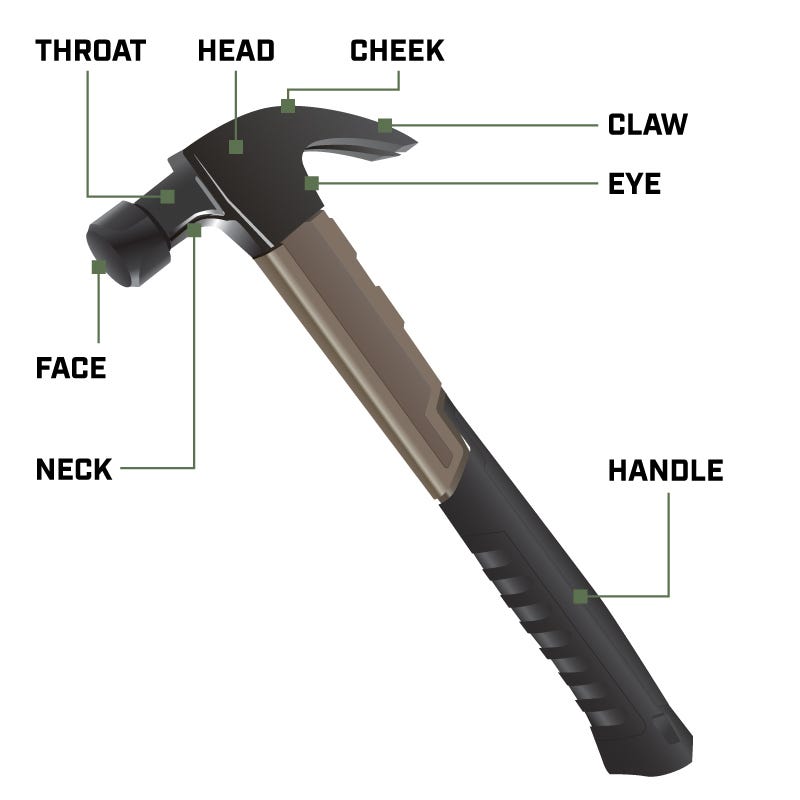Are you curious about what makes a claw hammer different from a general hammer? Let’s find out! 🛠️
You may have seen different types of hammers while working on a project or watching someone else fix things around the house. But have you ever wondered why some hammers have a claw on one side? 🤔
Well, my friend, a claw hammer is not your ordinary hammer. It’s a versatile tool that has a special feature designed to help you with tasks that require both pounding and pulling, like removing nails or prying things apart. Let’s dive deeper into the world of hammers and discover what sets claw hammers apart! 🚀

What Makes a Claw Hammer Different from a General Hammer?
Claw hammers and general hammers are both versatile hand tools used for various tasks, but they have distinct characteristics that set them apart. While general hammers are designed for pounding and driving nails, claw hammers have the added functionality of extracting nails. In this article, we will explore the key differences between these two types of hammers and understand their unique features and purposes.
1. Head Design and Function
The head of a claw hammer differs from a general hammer in both shape and functionality. A general hammer typically features a flat and smooth face, providing a large striking surface for pounding nails into various materials. On the other hand, a claw hammer has a dual-purpose head. One side has a flat face, similar to a general hammer, but the other side has a curved V-shaped claw. This claw allows the user to grip and pull out nails easily, making the claw hammer a versatile tool for both driving and removing nails.
The claw of a claw hammer is specifically designed to grip the protruding part of a nail. When the claw is placed against the wood or material, the user can apply leverage to pry the nail out. This functionality makes the claw hammer ideal for tasks such as remodeling, woodworking, and other projects that involve the removal of nails.
2. Weight and Balance
Another significant difference between a claw hammer and a general hammer is the weight and balance of the tool. Generally, claw hammers tend to be lighter than general hammers. This lighter weight allows for better control and maneuverability when using the claw hammer for extracting nails or performing precision tasks.
The balance of a claw hammer is also crucial. The weight of the head and handle should be evenly distributed to provide optimal control and reduce strain on the user’s arm and wrist. Manufacturers often take this into consideration when designing claw hammers, ensuring that the weight is evenly distributed to enhance usability and reduce fatigue.
3. Handle Design and Grip
The handle design and grip of a claw hammer play a vital role in its functionality and user comfort. Claw hammers typically have a curved or contoured handle, providing a comfortable grip during extended use. The curve in the handle allows for a more natural alignment of the hand, reducing wrist strain and improving control.
Furthermore, the grip of a claw hammer is often made of materials that provide a firm and non-slip surface. This ensures that the hammer does not slip out of the user’s hand, preventing accidents and improving overall safety. The handle design and grip of a general hammer may vary depending on the specific model, but they generally prioritize durability and comfort.
Overall, the design and grip of a claw hammer are optimized for both striking and extracting nails, making it the preferred choice for many professionals and DIY enthusiasts alike. Its versatility and ergonomic features make it a valuable tool in various industries, including construction, woodworking, and home improvement.
4. Materials and Durability
When it comes to durability and materials, both claw hammers and general hammers are typically constructed from high-quality steel. This ensures that the tool can withstand frequent use and heavy-duty tasks without succumbing to wear and tear.
However, the specific materials and construction methods used may vary between different brands and models. Some claw hammers may feature a reinforced handle made of fiberglass or other composite materials, enhancing durability and reducing the risk of the handle breaking under extreme force. General hammers may also have variations in materials and construction based on their intended use or specialty.
In terms of overall durability, both claw hammers and general hammers are built to withstand demanding tasks. Regular maintenance, such as cleaning and oiling the tool, can further enhance their lifespan and performance.
5. Purpose and Applications
The purpose and applications of claw hammers and general hammers differ primarily due to their unique features and functionalities. General hammers, with their flat striking surface, are primarily used for driving nails into different materials, such as wood, metal, or concrete. They are invaluable tools in construction, carpentry, and other industries where precise and controlled strikes are necessary.
On the other hand, claw hammers are designed for both driving and removing nails. The claw feature allows users to easily extract nails from surfaces, making it an essential tool for remodeling, demolition, and repair projects. The claw hammer’s versatility and ability to switch between driving and extracting functions make it a go-to choice for many professionals and DIY enthusiasts.
To summarize, the key differences between claw hammers and general hammers lie in their head design and functionality, weight and balance, handle design and grip, materials and durability, and purpose and applications. Understanding these differences can help individuals choose the most suitable hammer for their specific needs and tasks. Whether it’s driving nails or removing them, both types of hammers have their place in the toolbox and play crucial roles in a wide range of projects.
Key Takeaways: What Makes a Claw Hammer Different from a General Hammer?
- A claw hammer has a curved metal end called a claw, which is used for removing nails.
- A general hammer usually has a flat metal end and is used for driving nails into surfaces.
- The claw on a claw hammer provides functionality for both driving and removing nails.
- Claw hammers are often used in construction and carpentry work.
- A general hammer is more versatile and can be used for various tasks beyond just nailing and removing nails.
Frequently Asked Questions
Are claw hammers and general hammers the same? Let’s find out!
1. What is the main difference between a claw hammer and a general hammer?
The main difference between a claw hammer and a general hammer lies in their design and functionality. While both hammers are used for driving nails, a claw hammer features a unique curved claw on one side of the head. The claw is used for removing nails or prying objects apart, making it a versatile tool for both construction and demolition tasks. On the other hand, a general hammer usually has a flat head on both sides, making it more suitable for general hammering tasks.
In summary, the main distinction is that a claw hammer has a claw for nail removal, while a general hammer has a flat head on both sides for general hammering purposes.
2. Can you use a claw hammer instead of a general hammer for everyday tasks?
Yes, you can certainly use a claw hammer instead of a general hammer for everyday tasks. While the claw hammer is specifically designed for removing nails, its flat head can still be used for basic hammering tasks like hanging pictures or assembling furniture. However, it’s important to note that the curved claw might obstruct certain actions or make the hammer less efficient for certain tasks compared to a general hammer.
If you already have a claw hammer and need to perform general hammering tasks, it can still get the job done. However, if you anticipate needing a hammer primarily for general hammering purposes, a general hammer might be a better choice due to its flat dual-sided head.
3. Which hammer is more suitable for carpentry work?
When it comes to carpentry work, a general hammer is often the preferred choice. The flat dual-sided head of a general hammer allows for precise and controlled hammering, which is essential for delicate carpentry tasks. It provides a larger and more stable surface area to strike the nails, reducing the possibility of unwanted damage.
Although a claw hammer can still be used for carpentry work, its primary function for nail removal might make it less ideal for fine carpentry tasks. However, if there’s a need for occasional nail removal during carpentry work, having a claw hammer on hand can be useful.
4. Are claw hammers and general hammers available in different sizes?
Yes, both claw hammers and general hammers are available in a range of sizes. The size of the hammer refers to the weight of the head, typically measured in ounces. The most common sizes for claw hammers and general hammers range from 16 to 24 ounces, with variations on either end of the spectrum.
Choosing the right size hammer depends on the task at hand. Heavier hammers provide more power but can be more difficult to control, making them suitable for heavy-duty tasks. Lighter hammers offer better control and are more comfortable for extended use. It’s important to select the appropriate size hammer based on your specific needs and the type of work you’ll be doing.
5. Can one hammer replace both a claw hammer and a general hammer?
While it is possible for one hammer to perform both claw hammer and general hammer tasks, having separate hammers for these specific purposes is generally recommended. A specialized claw hammer with a curved claw is more efficient for nail removal and prying tasks, whereas a general hammer with a dual-sided flat head is better for general hammering.
Having the right tool for the job not only ensures better performance but also minimizes the risk of damaging the tool or the materials you’re working with. Therefore, it is advisable to have both a claw hammer and a general hammer in your toolkit to cover a wider range of tasks effectively and efficiently.

Summary
So, what’s the difference between a claw hammer and a general hammer? Well, a claw hammer has a curved, V-shaped head with one flat face and one pronged face, used for removing nails. On the other hand, a general hammer has a flat face on both sides and is used for tasks like pounding nails into wood.
So, if you need to pull out nails, go for a claw hammer. But for most other hammering jobs, a general hammer will do just fine!
